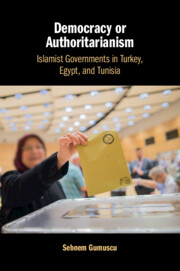Book contents
- Democracy or Authoritarianism
- Democracy or Authoritarianism
- Copyright page
- Contents
- Figures
- Acknowledgments
- Abbreviations
- Introduction
- 1 Modernization, Inclusion, and Power
- 2 A Theory of Intraparty Politics
- 3 The AKP’s Pivot from Liberal Democracy to Electoral Islamism
- 4 Electoral Islamism and Killing the Dream of a Democratic Muslim Brotherhood
- 5 Ennahda’s Path toward Liberal Islamism
- Conclusion
- Interviews
- Bibliography
- Index
5 - Ennahda’s Path toward Liberal Islamism
Published online by Cambridge University Press: 09 March 2023
- Democracy or Authoritarianism
- Democracy or Authoritarianism
- Copyright page
- Contents
- Figures
- Acknowledgments
- Abbreviations
- Introduction
- 1 Modernization, Inclusion, and Power
- 2 A Theory of Intraparty Politics
- 3 The AKP’s Pivot from Liberal Democracy to Electoral Islamism
- 4 Electoral Islamism and Killing the Dream of a Democratic Muslim Brotherhood
- 5 Ennahda’s Path toward Liberal Islamism
- Conclusion
- Interviews
- Bibliography
- Index
Summary
Only a few weeks after Mohamed Bouazizi set himself on fire, Ennahda returned to Tunisia from exile. The same year Ennahda won Tunisia’s first free and fair elections in its history. On the night of the election, Rached Ghannouchi, the leader of Ennahda, vowed to uphold the revolutionary goals of building a free and prosperous Tunisia. And his party kept this promise to build Tunisian democracy with other stakeholders. Why did Ennahda adhere to democratic principles in power and became a force for compromise, deliberation, and engagement? This chapter shows that competing political visions have coexisted within the party organization since its establishment in the 1980s, and since the 1990s liberal Islamists pulled Ennahda towards democratic commitments not only when they were in opposition but also after coming to power in 2011. To explain this process, the chapter first turns to the origins of the Islamist movement in Tunisia and its political and ideological evolution over time including Ghannouchi’s philosophical contributions. Then it explores the shifting balance of power among factions and factors, determining this balance with a specific emphasis on organizational resources and implications for Tunisian democracy.
Keywords
- Type
- Chapter
- Information
- Democracy or AuthoritarianismIslamist Governments in Turkey, Egypt, and Tunisia, pp. 202 - 254Publisher: Cambridge University PressPrint publication year: 2023

